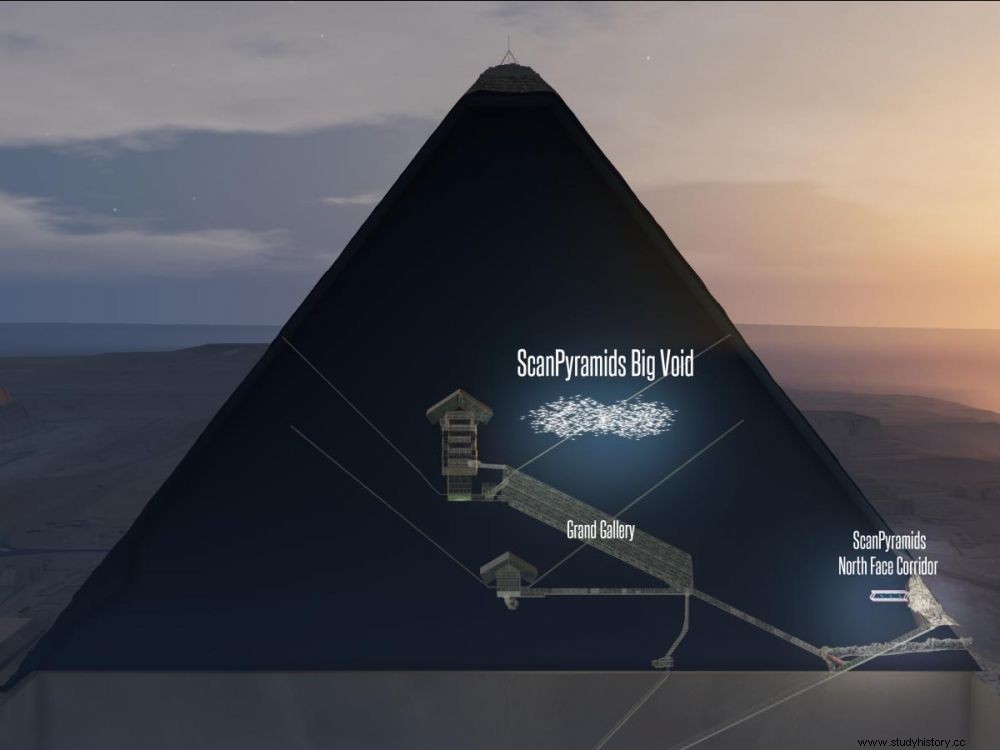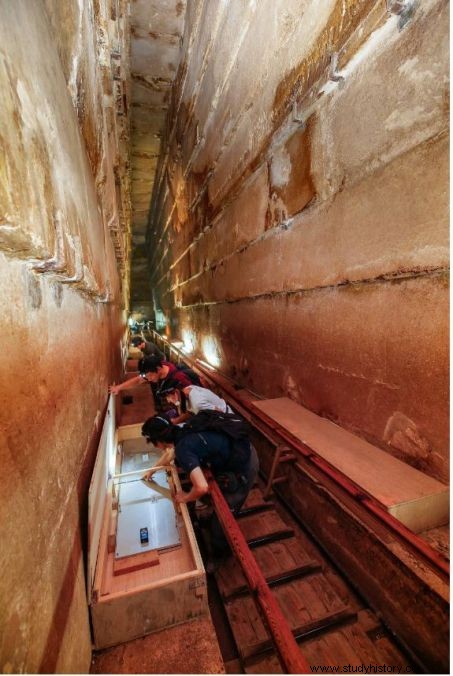After the discovery in 2017 of a huge "void" in the Great Pyramid, on the Giza plateau, in Egypt, the ScanPyramids mission delivers its latest results... And the mystery grows a little more!

3D image of the Great Pyramid of Cheops, and its horizontal representation of the "Big Void", the huge unknown cavity discovered by ScanPyramids above the Great Gallery in 2017. With, below, a corridor of more than 5 meters long detected in 2016 near the north face of the monument.
It is a video that takes stock of two additional years of measurements inside the pyramid of Cheops, in Egypt, since the discovery of a huge unsuspected cavity by the international teams of the ScanPyramids mission. Let's remember:the detection in the heart of the 4200-year-old building of an unknown cavity more than 30 m long, announced in the journal Nature in November 2017, shook the world of Egyptology… and beyond. "Since then, we have continued our measurements to try to understand the meaning", explains to Sciences et Avenir , Mehdi Tayoubi, co-director of the Franco-Egyptian project designed by Cairo University and the HIP Institute (Heritage Innovation Preservation) who has just uploaded the new video (see below).
Muons to assess the entrails of the Cheops pyramid
The presence of this gigantic "void" located above the Grand Gallery, between 60 meters and 70 meters in height, had been revealed thanks to the use of a non-invasive technology, muography*. This makes it possible to "radiograph" - as would X-rays - the monuments in depth by detecting the cosmic particles which cross it, as they do permanently and continuously for all the matter which surrounds us. This innovative technological approach had previously led to the discovery of the first "vacuums" as early as October 2016, as we wrote then in Sciences et Avenir :"A cavity of about 9 m 2 located on the northeast edge of the pyramid, spotted by muon telescopes from the CEA (Commissariat for Atomic Energy and Alternative Energies). But above all an unknown corridor at least 5 meters long, the "Scan Pyramids North Face Corridor" located just behind the monumental rafters visible on the North face of the pyramid ".

Installation by Japanese researchers from the University of Nagoya of films sensitive to muons in the Great Gallery of the Cheops pyramid. © ScanPyramids
Over the past two years, ScanPyramids teams have continued their work on the Giza plateau to refine and refine the measurements of the huge "void" (ScanPyramids Big Void or "SP-BV"). They positioned other chemical emulsion plates, muon "traps", in new locations inside the 139m high pyramid. In particular along the Grand Gallery, as well as below and above the so-called "King's Chamber". They also continued the measurements with two other independent devices that had already contributed to the discovery:a muon scintillator from the KEK Institute (High Energy Accelerator Research Organization), the Japanese equivalent of the CEA, installed in the lower parts of the pyramid and also intended to capture cosmic particles; and two CEA muon telescopes, deployed inside the Grand Hall. So many avant-garde technologies whose independent results have all intersected with precision.
An even longer cavity!
Exposed to muons during several campaigns, the analysis of the new chemical emulsion films and the CEA gas telescopes have corroborated the existence of the "Big Void" located between 10m and 15m above the Grand Gallery. But it also brought new and valuable information! "The length of the colossal cavity initially estimated at around thirty meters turns out to be in reality at least 40 meters and probably all in one piece! “, continues Mehdi Tayoubi. Determine the exact shape of this “Big Void”, trying to know if it is “a single structure or several adjacent ones”, in a row, was indeed one of the questions asked at the end of the first results. "Above all, we wanted to observe and reconfirm our 2017 results from new vantage points. This allowed us to see in new sectors . Thus we have not detected any anomaly between the top of what is called the King's Chamber and the top of the pyramid" . A space that had never been scanned before, and which harbors nothing suspicious.
Are scientists on the right track for a discovery of exceptional magnitude? Egyptologist Zahi Hawass, former Minister of Egyptian Antiquities, very reserved until then on the first announcements of an unknown cavity that he had tried to minimize, recently took the ScanPyramids teams by surprise. In an interview with Daily Express of November 14, 2019, he expressed his belief that "the body of Cheops could actually be hidden in this void" , endorsing all of the results all at once while creating unprecedented suspense! According to this specialist, still very influential in Egypt, the pyramid would contain many hidden voids, one of which "could have contained the long lost body of the ancient pharaoh ", ruler of the Fourth Dynasty. The current Egyptian Minister of Antiquities, Khaled El-Enany, has meanwhile specified that he is currently working "with archaeologists from all over the world " to solve this mystery. The answer could be provided in the coming months. ScanPyramids will indeed continue its measurements by penetrating even deeper within the 2.6 million m 3 of the monumental construction. One of the Seven Wonders of the World may be about to reveal its secret thanks to celestial muons.
* Muography:Non-invasive technique, using sensors to trap the cosmic particles that permanently bombard the Earth, and which, like natural X-rays capable of crossing very thick rocks, deliver an in-depth radiography buildings, indicating dense or empty areas.
